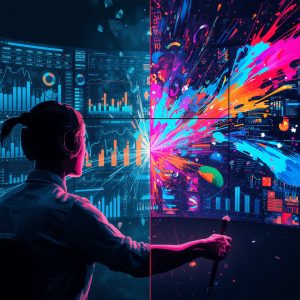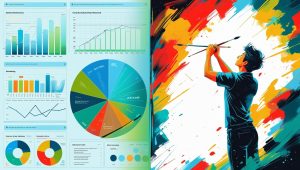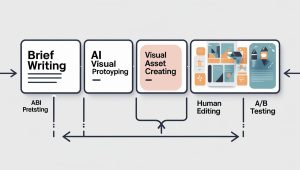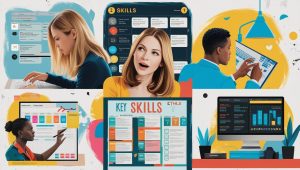Introduction

When most people hear “AI in marketing,” they think of dashboards, targeting, and A/B tests. That’s only part of the picture. Today, AI is influencing the creative core of marketing—how we brainstorm ideas, craft brand stories, design visuals, and produce videos. Instead of taking over human roles, AI acts as a fast creative partner that can explore many options in minutes while you choose the one that feels most aligned with your brand. This post guides you step by step through how AI boosts creativity—from concept to campaign—so you can move faster, stay original, and connect more deeply with your audience.

The Old Myth: Data vs. Creativity
Marketing teams used to divide into “numbers people” and “creatives.” Data showed who to target; creatives determined what to say and how it should look. AI is breaking down that divide. It uses data to improve creative decisions and then helps carry them out—making variations, simulating audience reactions, and revealing unexpected perspectives you might miss in a brainstorming session.

Where AI Touches Creativity (with quick examples)
Ideation & Concepting
– Generate 20 campaign themes from a single brief.
– Explore different narrative styles: humorous, emotional, minimalist, luxury.
Copywriting & Voice
– Draft headlines, hooks, product descriptions, ad variants, and email subjects.
– Adjust tone for different groups: playful for Gen Z, premium for high-value buyers.
Visuals & Design
– Create mood boards, ad mockups, and social media visuals based on style prompts.
– Revise quickly: “more minimalist,” “more editorial,” “add brand palette.”
Video & Audio
– Turn scripts or blog posts into short videos with voiceovers and captions.
– Generate storyboard frames to align the team before production.
Personalized Storytelling
– Assemble dynamic headlines and images based on user behavior or intent.
– Localize creative elements (festivals, cities, slang) while keeping brand voice.
Experimentation at Scale
– Produce many on-brand variations and test them inexpensively.
– Use results to refine the brief—what styles and angles truly resonate.

Step-by-Step: A Practical Workflow for AI-Enhanced Creativity
Step 1: Write a clear creative brief
Include the goal, audience, promise, proof, tone, and essential brand elements (logo, color palette, words to avoid).
Add 2–3 reference campaigns you admire and explain why.
Step 2: Brainstorm with AI (breadth first)
Prompt for 15–30 campaign angles, hooks, and story arcs.
Ask for opposites: “Give me the counterintuitive version,” “Make it contrarian,” “Make it cinematic.”
Choose 3–5 strong directions.
Step 3: Build messaging pillars
For the best concepts, have AI expand into taglines, value propositions, and calls to action.
Request variations for segments (new users vs. repeat customers, B2C vs. B2B).
Step 4: Prototype visuals quickly
Generate mood boards or concept images that match your brand adjectives.
Revise: “Cleaner layout,” “More negative space,” “Editorial photography feel.”
Step 5: Create multiformat assets
Turn the main message into short-form video scripts, carousels, display ads, and landing page sections.
Keep a shared checklist: headline, subhead, hero image, proof, call to action, social cutdowns.
Step 6: Human edit for brand soul
Tighten the language, add product details, ensure cultural sensitivity, and provide real insights.
Run a quick “brand voice” check: would your best customer believe this?
Step 7: Test, learn, refine
Launch small tests across different placements.
Use outcomes to refine your prompts: “Revise based on best-performing angle,” “Less salesy, more helpful.”

Prompts You Can Copy (and tweak)
Ideation: “You are a senior creative. Give me 15 campaign ideas for a [product] targeting [audience] that feels [tone: playful/luxury/minimal]. Include a 1-line slogan and a visual suggestion for each.”
Voice Adaptation: “Rewrite this headline in three tones—premium, witty, and educational—while keeping the core benefit intact: [paste text].”
Visual Direction: “Create a mood board description for an ad with [brand colors], [style references], and [emotion]. List 5 visual elements to include.”
Video: “Turn this blog into a 45-second script with hook, problem, solution, and call to action. Add suggested B-roll for each sentence.”

Guardrails: Keep Creativity Responsible & Original
Focus on originality: Start broad with AI, then edit carefully to avoid generic phrases.
Brand governance: Keep a living voice guide (do/don’t words, tone sliders, formatting).
Rights & references: Make sure you have rights to fonts, images, and likenesses. Don’t use prompts that closely imitate living artists’ styles.
Bias & sensitivity: Review portrayals of gender, culture, age, and body types.
Transparency: If suitable, disclose AI assistance in content creation.

Mini Case Walkthrough (Hypothetical)
A mid-sized skincare brand wants to launch a hydrating serum.
Brief: “Hydration that survives a busy city day; audience: 22–35, urban professionals; tone: clean and modern.”
AI Ideation: 25 campaign hooks; shortlist includes “City-Proof Glow.”
Messaging Pillars: Science-backed hydration, pollution defense, 8-hour glow.
Visuals: Minimalist layouts; soft natural light; urban backdrops with subtle mist.
Assets: 3 short videos (15s, 30s, 45s), 6 static ads, 1 landing page section, 5 email subject lines.
Human Edit: Add dermatologist quote, specific ingredient benefits, and user-generated content tone.
Test: Two hooks on Instagram Reels and YouTube Shorts; refine copy to highlight “glow that lasts after commute.”

Skills Creatives Need in the AI Era
Promptcraft: Framing precise, constraint-rich prompts.
Curation: Selecting standout ideas and developing them further.
Brand storytelling: Keeping narrative continuity across formats.
Ethical awareness: Knowing where the lines are—and why they matter.
Performance fluency: Reading signals and evolving the creative approach.

Conclusion
AI isn’t just improving CPMs—it’s changing the way we do creative work. It can enhance your imagination, speed up production, and customize stories at scale. But the true magic occurs when human judgment meets machine speed: you bring taste, empathy, and brand truth; AI brings variety, iteration, and momentum. Start with a tight brief, explore widely with AI, refine using your voice, and test until you achieve strong results. The outcome is creativity that’s faster, sharper, and more human than ever—ironically, because you used a machine to get there.